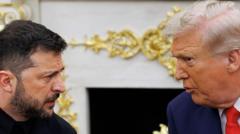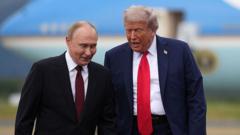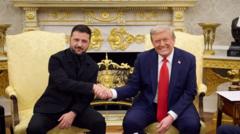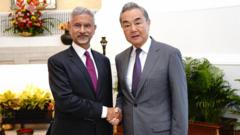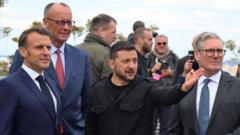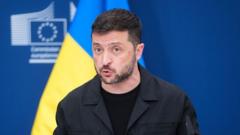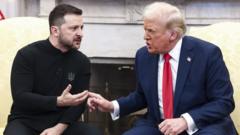The dynamic between Trump and Zelensky reflects contrasting perspectives on the territorial situation in Ukraine amidst ongoing warfare.
**Trump's Oval Office Map: A Key Element in Ukraine War Discussions**
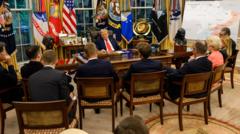
**Trump's Oval Office Map: A Key Element in Ukraine War Discussions**
The map showcased in the Oval Office highlights the significant Russian occupation of Ukrainian territory, impacting the dialogue between President Trump and President Zelensky.
In the Oval Office, a large map indicating Russian-occupied territories in Ukraine has become a focal point of discussions between President Donald Trump and Ukrainian President Volodymyr Zelensky. During a recent interview, Trump emphasized the stark reality depicted on the map, illustrating that Russia controls a significant portion of Ukrainian land, an assertion he reiterated while speaking to Fox News.
The imagery of the map, with large areas shaded in red to represent regions occupied by Russia, serves as a visual simplification of the conflict for the U.S. President, potentially hinting at U.S. openness to territorial compromises in favor of a negotiated settlement with Russian President Vladimir Putin. Zelensky, however, countered this narrative by presenting his own map during their meeting, indicating that he is striving to reclaim territories “not by hearsay, but in reality."
Despite Zelensky's attempts to influence the narrative, Trump's perception remained unchanged, acknowledging Russia's considerable military strength. This discord highlights the differing views on the path forward regarding areas like the Donbas, where Russian forces hold significant control.
International opinion is split, with discussions among European allies hinting at the possibility of land swaps in pursuit of a cessation of hostilities. Notably, Zelensky stressed the importance of accurate representations of territorial control, highlighting that the Ukrainian resistance has still maintained substantial control despite Russian advances.
Recent analysis from multiple think tanks, including the Institute for the Study of War, indicates that while Russia has made some recent gains, especially in specific eastern regions, it may take years for them to secure complete control over contested areas like Donetsk. Experts assert that Ukraine remains resilient, as evidenced by their reclaiming efforts, despite extensive Russian efforts and recruitment drives aimed at fortifying the ground troops.
Strategically, both leaders face immense pressure; Trump, navigating a complex foreign policy landscape, and Zelensky, who must balance national integrity with international diplomacy amidst an ongoing and violent conflict. Their discussions exemplify the nuanced terrain of modern geopolitics where maps become canvases for broader territorial battles, illuminating the stark contrasts and contentious dynamics over Ukraine’s future.
As the talks continue, Zelensky expressed appreciation for the map while maintaining his commitment to reclaiming lost territories, a reminder of the high stakes involved in their dialogue. The ongoing war in Ukraine showcases the critical interplay between territorial representation and diplomatic negotiations, shaping the future of the region amidst escalating tensions.
The imagery of the map, with large areas shaded in red to represent regions occupied by Russia, serves as a visual simplification of the conflict for the U.S. President, potentially hinting at U.S. openness to territorial compromises in favor of a negotiated settlement with Russian President Vladimir Putin. Zelensky, however, countered this narrative by presenting his own map during their meeting, indicating that he is striving to reclaim territories “not by hearsay, but in reality."
Despite Zelensky's attempts to influence the narrative, Trump's perception remained unchanged, acknowledging Russia's considerable military strength. This discord highlights the differing views on the path forward regarding areas like the Donbas, where Russian forces hold significant control.
International opinion is split, with discussions among European allies hinting at the possibility of land swaps in pursuit of a cessation of hostilities. Notably, Zelensky stressed the importance of accurate representations of territorial control, highlighting that the Ukrainian resistance has still maintained substantial control despite Russian advances.
Recent analysis from multiple think tanks, including the Institute for the Study of War, indicates that while Russia has made some recent gains, especially in specific eastern regions, it may take years for them to secure complete control over contested areas like Donetsk. Experts assert that Ukraine remains resilient, as evidenced by their reclaiming efforts, despite extensive Russian efforts and recruitment drives aimed at fortifying the ground troops.
Strategically, both leaders face immense pressure; Trump, navigating a complex foreign policy landscape, and Zelensky, who must balance national integrity with international diplomacy amidst an ongoing and violent conflict. Their discussions exemplify the nuanced terrain of modern geopolitics where maps become canvases for broader territorial battles, illuminating the stark contrasts and contentious dynamics over Ukraine’s future.
As the talks continue, Zelensky expressed appreciation for the map while maintaining his commitment to reclaiming lost territories, a reminder of the high stakes involved in their dialogue. The ongoing war in Ukraine showcases the critical interplay between territorial representation and diplomatic negotiations, shaping the future of the region amidst escalating tensions.

